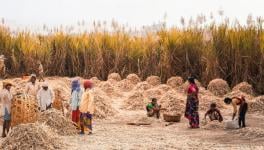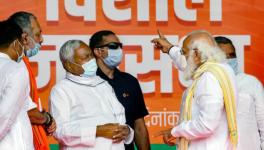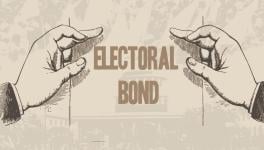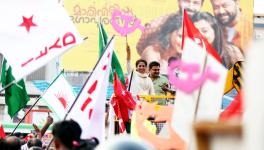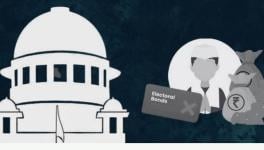Latest Family Spending Data Paints Bleak Picture of Incomes
After a long wait of 11 years, the government finally released summary data for how much each person spends on all consumption in a month, known formally as Monthly Per Capita Expenditure (MPCE). Since there are no income surveys in India, this consumption expenditure data serves as a proxy for incomes – one can get an approximate idea of how much a family is earning from the numbers for how much it is spending.
The data shows an abysmally low level of spending which indicates low incomes, and it appears that in price adjusted terms, there has been a very small increase in incomes in the past 11 years since the last survey of consumption expenditure was reported back in 2011-12.
As shown in the chart below, average monthly consumption spending per person was just Rs.3,773 in rural areas and Rs.6,549 in urban areas according to the latest data. It may appear that there is a substantial increase since 2011-12, when the rural MPCE was Rs.1430 and the urban one was Rs.2630. But this increase is illusory because most of it can be ascribed to price rise. If current figures are adjusted to inflation – by expressing them in 2011-12 price terms – then the real picture emerges.
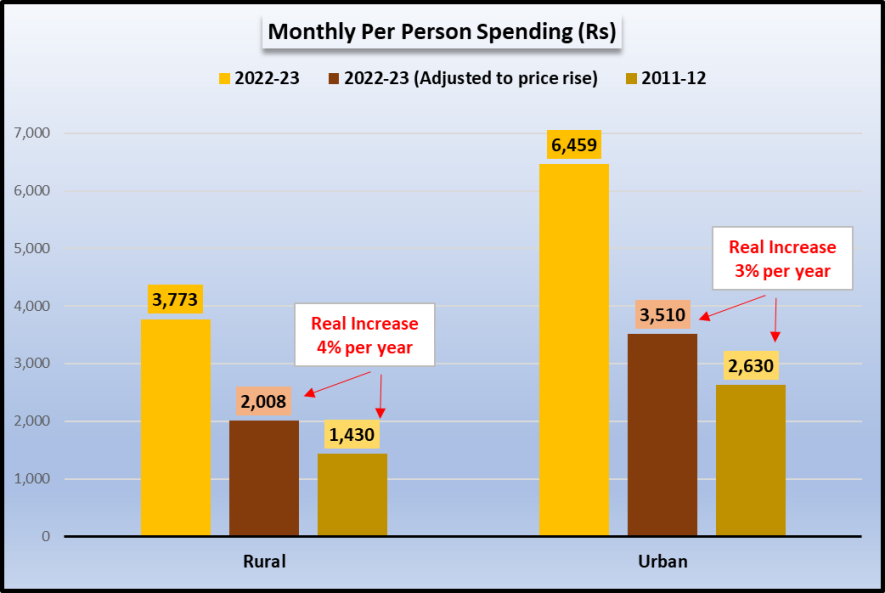
After such adjustment to inflation, what emerges is this. for rural areas, monthly per capita spending has increased from Rs.1430 in 2011-12 to Rs.2008 in 2022-23. That’s an annual growth rate of about 4% only. For urban areas, the monthly per capita spend has increased from Rs.2630 in 2011-12 to Rs.3510 currently – an increase rate of just 3% annually.
To get an idea of how much a family of four spends all that is needed is to multiply these numbers by four. Thus, in rural areas, the average monthly spending of a such a family will be Rs.8032, at 2011-12 prices or Rs.15,092 in current prices. Similarly, in urban areas, for a four member family, average spend per month would be Rs.10,520 in 2011-12 prices or Rs.14,040 in current prices. In either case, this would roughly be a measure of their respective incomes also.
Wide Gap Between Rich and Poor
The summary data includes a shocking picture of disparity between the rich and poor. In rural areas, the poorest 5% of population spends just Rs.1373 per person on consumption every month while the richest 5% spends Rs.10,501 per person. That means that the rich elite spend almost 8 times more than the poorest.
In urban areas, also there is a similar chasm – the poorest 5% spend Rs.2001 per person per month while the richest 5% spend Rs.20,824 per person. That means the spending of the richest is about 10 times more than the poorest.
In fact the data shows that in rural areas, 70% of the population spends less than Rs.4000 per person per month while in urban areas, 50% of the population spends less than Rs.5000 per person per month.
Low Incomes of SC/ST
The summary data includes a breakup of MPCE across various social groups. It reveals that members of Scheduled Castes (SC) and Scheduled Tribes (ST) have the lowest per capita spending reflecting their low income levels.
In rural areas, the average monthly per person spending was Rs.3016 for Adivasis (ST community members), Rs.3474 for Dalits (SC community members), Rs.3848 for Other Backward Classes (OBCs) and Rs.4392 for all others which would be the so called ‘upper castes’ as well as followers of other faiths.
In urban areas, the average monthly per person spending was Rs.5414 for Adivasis, Rs.5307 for Dalits, Rs.6177 for OBCs and Rs.7333 for all others.
How Much Do Govt Welfare Schemes Help?
An interesting aspect of this summary report is that separate data has been given accounting for the fact that there are several government schemes that provide free or subsidised items of consumption to the people. These include free food grain given under the PM Garib Kalyan Anna Yojana that gave 5 kg food grain free of cost to all ration card holders (and other vulnerable sections) during the pandemic. Approximations for other free items like laptops, mobile handsets, bicycles, school uniforms, etc. have also been imputed.
The results are eye-opening. For rural areas, the difference between monthly per person spending with these costs included is merely Rs.87! Without these costs, the monthly spend was recorded at Rs.3773 while with these costs included it was Rs.3860. If current prices are adjusted to inflation then the difference reduces even further – to just Rs.46. Similarly in urban areas, the difference between the monthly spending with or without costs of welfare schemes benefits is a measly Rs.62 per person. This reduces further to Rs.34 per person if inflation adjustment is done.
This shows that the hype about revdis and freebies is grossly misplaced. But it also shows that there is so much distress among the people that even small amounts of help is popular and accepted gratefully.
Get the latest reports & analysis with people's perspective on Protests, movements & deep analytical videos, discussions of the current affairs in your Telegram app. Subscribe to NewsClick's Telegram channel & get Real-Time updates on stories, as they get published on our website.









